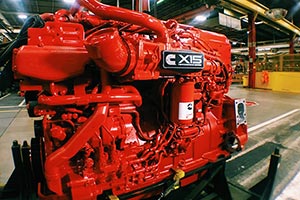Cummins Rolls Out 2017 Greenhouse Gas Compliant X15 Engines

Cummins Inc. rolled out its X15 heavy-duty engine at its engine plant in Jamestown, New York, saying it exceeds the U.S. Environmental Protection Agency 2017 greenhouse gas and fuel-efficiency standards.
Two configurations are available: the X15 Performance Series and the X15 Efficiency Series, Columbus, Indiana-based Cummins said. Both configurations are available in limited production through the remainder of 2016, with full production beginning in January 2017, the company said.
The X15 Performance Series is rated at 485 to 605 horsepower, a power match for heavy-haul, vocational and emergency vehicles with a peak torque of up to 2,050 pound-feet delivered across a wide engine rpm range, and up to 600 horsepower engine braking at 2,100 rpm, the company said.
For linehaul and regional-haul applications, the X15 Efficiency Series offers a 400 to 500 horsepower ratings range and up to 1,850 pound-feet of peak torque available at 1,000 rpm, the company said.
The new X15 builds on the current ISX15 product and uses an optimized compression ratio, air handling system and combustion process to increase both fuel efficiency and performance capability, Cummins said.
The engine has about a 20% better fuel economy and 40% lower maintenance costs than 2010 ISX15 engines, Cummins said.
The X15 also comes factory-ready to connect to a telematics system that enables over-the-air engine programming, customization and diagnostics, according to the company.
“I am proud of the innovative, hard work that has gone into this game-changing engine platform, and we are excited to see these important products rolling off the line,” said Srikanth Padmanabhan, president of Cummins engine business. “Attention to detail was paramount from product design to our talented colleagues bringing them to life on the manufacturing floor, to every step in between.”
The second half of federal greenhouse gas and fuel-efficiency Phase 1 standards are due to take effect Jan. 1, 2017. The GHG Phase 1 rule called for an initial reduction of carbon dioxide emissions and improvement in mileage standards by 3%, from a 2010 baseline, by January 2014. The upcoming second step moves that another 3%.

